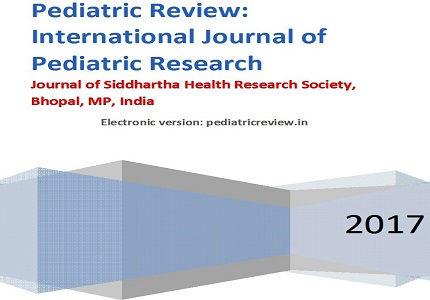Low birth weight new born: epidemiological, therapeutic and evolutive aspects in the commune of Kara (TOGO) from 2014 to 2015
Abstract
Introduction: Low birth weight (LBW) is the third leading cause of neonatal death after neonatal infections and asphyxia.
Objective: Describe the epidemiological, therapeutic and evolutionary effects of LBW neonates.
Methods: This was an analytical retrospective study from January 1, 2014 to December 31, 2015, in three neonatal units in Kara commune concerning the LBW newborn. The main parameters studied were clinical, therapeutic and evolutionary.
Results: Of 1712 newborns hospitalized, 527 were LBW (30.8%) of which 451 were included with 222 males (sex ratio 0.97). The average birth weight was 1775.72 g. Delivery was carried out through caesarean section in 16.9% mainly did about eclampsia (29.5%) and prævia hemorrhagic placenta (12.6%). The main co-morbidities were neonatal infections (55.4%) and perinatal asphyxia (12.9%). The treatment consisted of an antibiotic therapy (73.8%), an exclusive breastfeeding (43.7%) and Kangaroo Maternal Care (30.2%). Immediate results were marked by deaths in 18.8% after an average of 6 days hospital admission. The main factors significantly related to neonatal mortality were the early neonatal period, low sucking, hypotonia, high preterm birth, very LBW, inadequate pregnancy monitoring, referrals, perinatal asphyxia, artificial breastfeeding.
Conclusion: The incidence of LBW remains high with significant mortality due to preventable factors, requiring actions to be coordinated from conception through the end of the period to improve the survival of these newborns.
Downloads
References
2. Black RE, Victora CG, Walker SP, Bhutta ZA, Christian P, De Onis M et al. Maternal and Child Nutrition Study Group. Maternal and child undernutrition and overweight in low-income and middle-income countries. Lancet. 2013 Aug 3;382(9890):427-451. doi: 10.1016/S0140-6736(13)60937-X. Epub 2013 Jun 6. [PubMed]
3. Katz J, Lee AC, Kozuki N. Mortality risk in preterm and small-for-gestational-age infants in low-income and middle-income countries: a pooled country analysis. Lancet. 2013 Aug 3;382(9890):417-425. doi: 10.1016/S0140-6736(13)60993-9. [PubMed]
4. Oestergaard MZ, Inoue M, Yoshida S, Mahanani WR, Gore FM, Simon C, et al. On behalf of the United Nations Inter-agency Group for Child Mortality Estimation and the Child Health Epidemiology Reference Group: Neonatal mortality levels for 193 countries in 2009 with trends since 1990: a systematic analysis of progress, projections, and priorities. PLoS Med.2011 Aug;8(8):e1001080. doi: 10.1371/journal.pmed.1001080. Epub 2011 Aug 30. [PubMed]
5. Rajaratnam JK, Marcus JR, Flaxman AD, Wang H L-R A, Dwyer L, Lopez AD, et al. Neonatal, postneonatal, childhood, and under-5-mortality for 187 countries, 1970–2010; a systematic analysis of progress towards Millennium Development Goal 4. Lancet 2010, 375:1988–2008.
6. Ministère de la Planification, du Développement et de l’Aménagement du Territoire (MPDAT), Ministère de la Santé (MS) et ICF International. Enquête Démographique et de Santé au Togo 2013-2014. Maryland, USA: MPDAT, MS et ICF International, 2015.
7. Djadou KE, Takassi OE, Guedéhoussou T, Faiwoo KM, Guedénon KJ, Atakouma YD. Facteurs liés au petit poids de naissance au Togo. Méd Périnat 2017. DOI 10.1007/s12611-017-0437-5.
8. Balaka B, Baeta S, Agbèrè AD, Boko K, Kessie K, Assimadi K. Facteurs de risque associés à la prématurité au CHU de Lomé, Togo. Bull Soc Pathol Exot. 2002 Nov; 95(4): 280-3.
9. Azoumah KD, Balaka B, Aboubakari AS, Matey K, Yolou A, Agbèrè AD. Morbidité et mortalité néonatales au CHU Kara (Togo). Méd Afr Noire 2010; 57 (2) : 109 -12.
10. Etuk SJ, Etuk JS, Oyo-Ita AE. Factors influencing the incidence of pre-term birth in Calaba, Nigeria. Niger J Physiol Sci 2005; 20 (1-2):63-8.
11. Rabesandratana M, Hanitriniaina L, Randriamanantena R, Rafaralado L, Randasharison P, Andrianarimanana D. Profil épidémio-clinique des nouveau- nés prématurés au CHU Mahajanga. Revue Electronique en Sciences de la Santé 2010 May; (1):70-9.
12. Siza JE. Risk factors associated with low weight of neonates among pregnant women attending a referral hospital in Northern Tanzania. Tanzania J Health Res 2008; (10) 1: 1-8. [PubMed]
13. Ndiaye O, Diallo DBa MG, Diagne I, Moreau JC, Diadhiou F. Facteurs de risques maternels et petit poids du nouveau-né chez les adolescents sénégalais: l'exemple d'un centre hospitalier de Dakar. Santé 2001; (11) 4: 241-4.
14. Negi KS, Kandpal SD, Kukreti M. Epidemiological Factors Affecting Low Birth Weight. JK Sci. 2006; 8 (1): 31-4.
15. Kanmiki E, Bawah A, Agorinha I, Achana F, John K, Abraham R, et al. Socioeconomic and demographic determinants of under-five mortality in rural northern Ghana. BMC Int Health Hum Rights. 2014 Aug 21; 14:24.
16. Tchagbele OB, Azoumah KD,Segbedji KAR, Kpegouni M, Djadou KE, Balaka B, Atakouma DY, Agbèrè AD. Évaluation des compétences des prestataires de soins exerçant dans les maternités en matière de réanimation néonatale au Togo. Rev Méd Périnat 2015; 7 : 245-53.
17. Whitelaw A, Stealth K. Myth of the marsupial mother: home care of very low birth weight babies in Bogota, Colombia. Lancet 1985; 1: 1206–8.
18. Eloundou OE. Etiologies et facteurs aggravant la morbidité et la mortalité néonatales à l'Hôpital Gynéco-Obstétrique et Pédiatrique de Yaoundé (HGOPY). Thèse de Méd. Faculté de Médecine et des Sciences Biomédicales-Université de Yaoundé I 2006.

Copyright (c) 2017 Author (s). Published by Siddharth Health Research and Social Welfare Society

This work is licensed under a Creative Commons Attribution 4.0 International License.


 OAI - Open Archives Initiative
OAI - Open Archives Initiative


